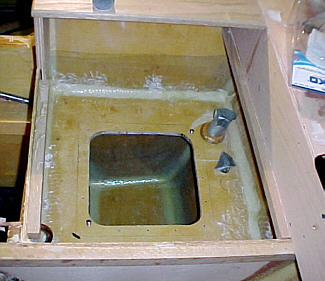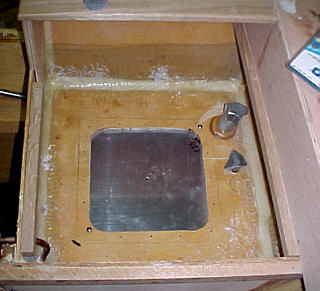|
Page 17
When I built my tanks from fiberglass 15 years ago ethanol was rare. Many epoxy resins will handle normal gasoline with no problems. I had no trouble with my tanks. But now it appears things have changed. Lovely! I had bought my resin at Wicks Aircraft and at the time of purchase I explained very clearly my intended use and ask for their recommendation of resin. I took their advice – after all they are the experts and sell supplies to people the homebuild aircraft. I called them back and asked about its resistance to ethanol. The hesitated for a moment and then said, Well it might be a problem but we haven’t had any calls about this particular product. But just to be safe maybe you should do a lay-up and let it soak in gas with ethanol for 3 to six weeks and see what happens.” Lovely! At first I thought the heck with it, I will cut the tops out of my built in tanks and drop a factory made aluminum or plastic tank in the hole. I spent hours looking for a tank that was near the size I needed to fit. Found some but it would cut my total capacity to about 18 gallons - no near enough for my intended purpose. If I were to cut a hole in the aft bulkhead and let it stick out 4 inches I found some that would get me to 24 gallons. I guess I could live with that but I really didn't want to have it sticking out. I thought about cutting the aft bulkhead completely out and moving it 4 inches forward but that would be a real mess. Thought about making custom tanks myself but my aluminum welding skills leave a lot to be desired and the mental image of my Skiff experiencing a fiery Hollywood type explosion convinced me look else where. Though about looking for someone else to make them for me but I know
the price would More hours of searching. Looking on the Web I found several products that MIGHT work and several that wouldn’t. I also found that ethanol is nasty stuff. Some of these products would hold battery acid with no problem but ethanol ate it to pieces! What is available are “sloshing sealers.” Their primary use is to seal auto gas tanks that have serious interior rust and/or pin hole leaks. Most all say the will withstand ethanol. The idea is you remove the tank, clean it out, seal up holes for the fuel lines, pour the stuff in the fill tube and seal it up and then slowly rotate the tank. This coats the interior and then the excess is poured off. When it cures the tank is sealed. I narrowed it down to three products that I though might seal my tanks but my application was different. First I was applying it to fiberglass not metal. Next, unless I could hire King Kong for a day it would be hard to “slosh” my tank. I called all three and talked to company reps and explained my problem - Will it work on fiberglass and can I brush, roll or spray it on? My first choice was a product called “U.S. Standard Fuel Tank Sealer.” I talked to a rep and he said he, “Saw no reason that it wouldn’t work on fiberglass and I could brush or roll it.” It made me nervous that he “saw no reason it wouldn’t work.” He didn’t say he KNEW it would work just that he thought it should. If there is one thing I have learned with this building project it is IF IT IS IMPORTANT NEVER TAKE THE WORD OF ONE TECH REP. ALWAYS, ALWAY CALL BACK AND TALK TO A DIFFERENT PERSON AND SEE IF YOU GET THE SAME ANSWER. I called back the next day the guy I talked to then said absolutely not – it would not adhere to fiberglass - who told you that! Lovely. The next product was “Bill Hirsch Gas Tank Sealer.” It was advertised as working with fiberglass but they were reluctant to have it brushed or rolled on. The problem is it needs to be a uniform thickness for proper curing to occur. If in the brushing process it was allowed to “puddle” it would dry by just skinning over on the top and stay liquid below. This would cause a problem and allow the gas to eventually penetrate it and allow it to peel off the surface. They said I might get away with it but they couldn’t recommend it. (If I could slosh the tank this is the stuff I would use). My final option was a product called “Epoxy Gas Tank Sealer” from Caswell Plating. I talked to them (Twice!) and they swore that ethanol would not harm this resin and I could brush or roll it on just like any epoxy (they said it is about the consistency of maple syrup). Actually this was my first choice for a fix but I hesitated because of my extreme sensitivity to epoxy. My personal thought was that I would have a better shot making a lasting bond applying epoxy to epoxy rather than another type of sealer. But now it was my ONLY choice. I placed the order and am waiting for it to arrive.
An added benefit is the removable cover will provide me with an easy way to open and inspect the tank. This way I can be SURE that all is well and the resin is not being affected. Also I have done a sample lay-up and am going to coat a strip of it with the epoxy sealer. I will place a bare piece and the coated piece in gas containing ethanol and let them set and check every month or so to see what is happening. At the present this whole situation is somewhat of a moot point. Currently I can locally buy regular unleaded auto gas (87 octane) with no ethanol blended. Interestingly though ALL the unleaded Plus (89 octane) has ethanol. Most of the Premium (92 octane) is also ethanol free but who can afford it! Also from what I have read the effects of ethanol on epoxy is gradual and it takes a while for it to do damage. So if I got caught away from home and had to use gas with ethanol, as long as I used it in a day or so little damage should occur. But know one knows how long before ALL gas has ethanol. The EPA seems to be leaning that way. So I think I have a fix but only time will tell. I will be monitoring the interior of the tank on a regular basis looking for any problems. And if anyone else spots any dumb mistakes I am making, Please drop me a note - I welcome ALL input. Also I think I have found the answer to my problem of applying the epoxy without a serious reaction – my lovely wife has gotten tired of hearing me whine about the situation and has offered to “paint” the inside of the tanks for me. Now is that love or what!
For Additional
Info On The Ethanol/Epoxy Test Jump Directly To
Page 27 
|
 I recently received an
interesting email about my Cabin Skiff project. The author asked how
I was addressing the problem of fiberglass tanks and ethanol used in auto
gas. My answer was “What problem!” He brought to light that
there is a serious concern with ethanol attacking epoxy resin and causing
it to delaminate. The situation has been documented with
homebuilt aircraft and the FAA will not allow any aircraft with a
fiberglass tank to use auto gas (aviation gas has no ethanol).
I recently received an
interesting email about my Cabin Skiff project. The author asked how
I was addressing the problem of fiberglass tanks and ethanol used in auto
gas. My answer was “What problem!” He brought to light that
there is a serious concern with ethanol attacking epoxy resin and causing
it to delaminate. The situation has been documented with
homebuilt aircraft and the FAA will not allow any aircraft with a
fiberglass tank to use auto gas (aviation gas has no ethanol).
 In order to apply it I
have cut a 10” square hole in the top of each tank ( photos above).
This should allow me to reach inside where I can clean and lightly sand
all the surfaces. To seal the hole I have cut two 12” x 1/8”
aluminum plates. I have drilled matching holes in both the plates
and the edge of the plywood lids. The plate will actually be
installed on the “inside.” This way the screws will be holding to
the plate not the wood. I was afraid if the plate were on the top I
would get fuel leaching up around the threads of the screws and eventually
saturate the wood. This way I will have a sealer (I think Permatex
will work) between the plate and the wood. (NOTE - Permatex was
a mistake! The gasoline dissolved it into very fine particles which
actually got through my filters and partially clogged a carburetor .)
In order to apply it I
have cut a 10” square hole in the top of each tank ( photos above).
This should allow me to reach inside where I can clean and lightly sand
all the surfaces. To seal the hole I have cut two 12” x 1/8”
aluminum plates. I have drilled matching holes in both the plates
and the edge of the plywood lids. The plate will actually be
installed on the “inside.” This way the screws will be holding to
the plate not the wood. I was afraid if the plate were on the top I
would get fuel leaching up around the threads of the screws and eventually
saturate the wood. This way I will have a sealer (I think Permatex
will work) between the plate and the wood. (NOTE - Permatex was
a mistake! The gasoline dissolved it into very fine particles which
actually got through my filters and partially clogged a carburetor .)